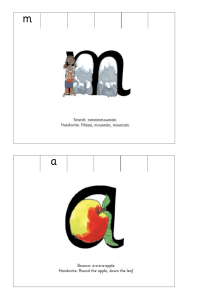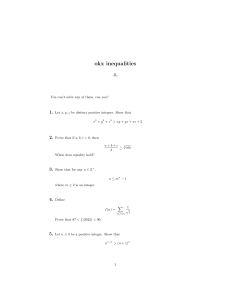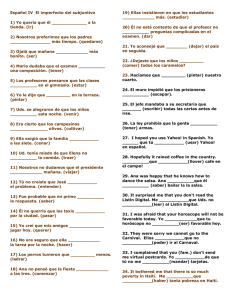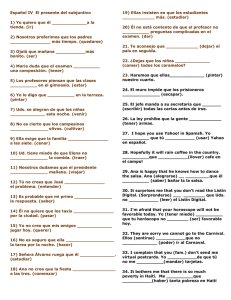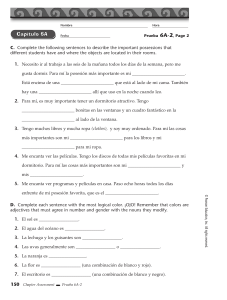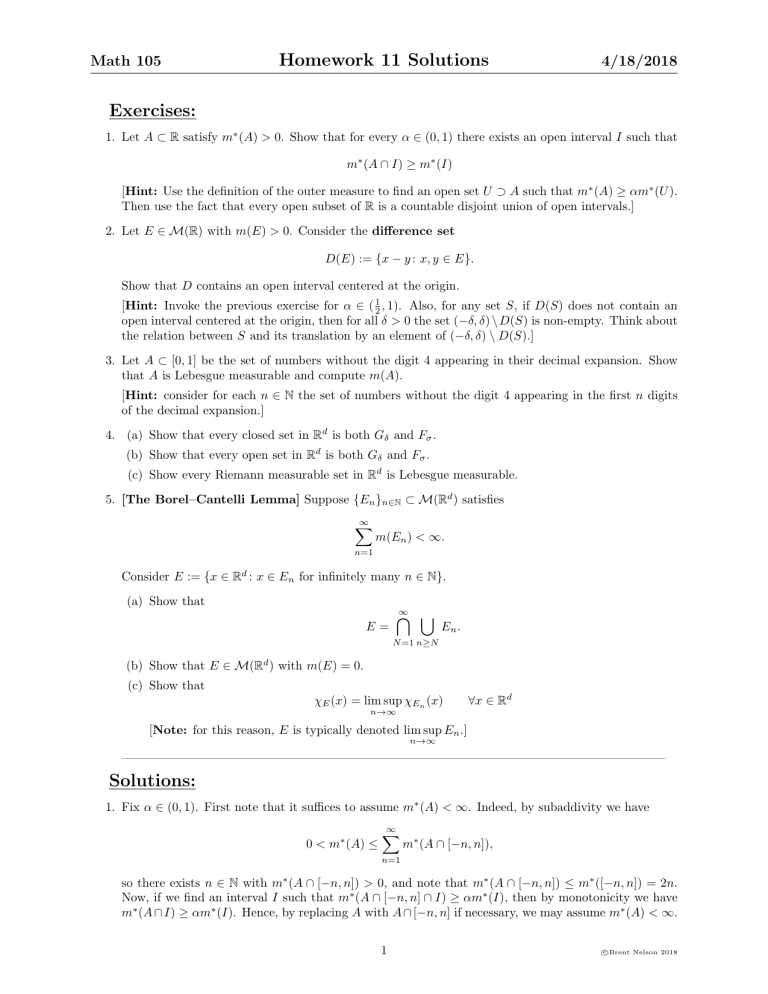
Math 105
Homework 11 Solutions
4/18/2018
Exercises:
1. Let A ⊂ R satisfy m∗ (A) > 0. Show that for every α ∈ (0, 1) there exists an open interval I such that
m∗ (A ∩ I) ≥ m∗ (I)
[Hint: Use the definition of the outer measure to find an open set U ⊃ A such that m∗ (A) ≥ αm∗ (U ).
Then use the fact that every open subset of R is a countable disjoint union of open intervals.]
2. Let E ∈ M(R) with m(E) > 0. Consider the difference set
D(E) := {x − y : x, y ∈ E}.
Show that D contains an open interval centered at the origin.
[Hint: Invoke the previous exercise for α ∈ ( 21 , 1). Also, for any set S, if D(S) does not contain an
open interval centered at the origin, then for all δ > 0 the set (−δ, δ) \ D(S) is non-empty. Think about
the relation between S and its translation by an element of (−δ, δ) \ D(S).]
3. Let A ⊂ [0, 1] be the set of numbers without the digit 4 appearing in their decimal expansion. Show
that A is Lebesgue measurable and compute m(A).
[Hint: consider for each n ∈ N the set of numbers without the digit 4 appearing in the first n digits
of the decimal expansion.]
4. (a) Show that every closed set in Rd is both Gδ and Fσ .
(b) Show that every open set in Rd is both Gδ and Fσ .
(c) Show every Riemann measurable set in Rd is Lebesgue measurable.
5. [The Borel–Cantelli Lemma] Suppose {En }n∈N ⊂ M(Rd ) satisfies
∞
X
m(En ) < ∞.
n=1
Consider E := {x ∈ Rd : x ∈ En for infinitely many n ∈ N}.
(a) Show that
∞ [
\
E=
En .
N =1 n≥N
(b) Show that E ∈ M(Rd ) with m(E) = 0.
(c) Show that
χE (x) = lim sup χEn (x)
n→∞
∀x ∈ Rd
[Note: for this reason, E is typically denoted lim sup En .]
n→∞
———————————————————————————————————————————–
Solutions:
1. Fix α ∈ (0, 1). First note that it suffices to assume m∗ (A) < ∞. Indeed, by subaddivity we have
∗
0 < m (A) ≤
∞
X
m∗ (A ∩ [−n, n]),
n=1
so there exists n ∈ N with m∗ (A ∩ [−n, n]) > 0, and note that m∗ (A ∩ [−n, n]) ≤ m∗ ([−n, n]) = 2n.
Now, if we find an interval I such that m∗ (A ∩ [−n, n] ∩ I) ≥ αm∗ (I), then by monotonicity we have
m∗ (A ∩ I) ≥ αm∗ (I). Hence, by replacing A with A ∩ [−n, n] if necessary, we may assume m∗ (A) < ∞.
1
c Brent Nelson 2018
Homework 11 Solutions
Math 105
4/18/2018
[Alternatively: if m∗ (A) = ∞ then we can simply take I = R.]
Now, for = ( α1 − 1)m∗ (A), let {Bk }k∈N be a countable covering of A by open boxes (intervals in this
case) satisfying
∞
X
|Bk | ≤ m∗ (A) + .
k=1
Set U =
∞
[
Bk , the U is open as the union of open sets. By countable subadditivity and our compu-
k=1
tation of the outer measure of boxes from class we have
m∗ (U ) ≤
∞
X
m∗ (Bk ) =
k=1
∞
X
|Bk | ≤ m∗ (A) + = m∗ (A) + (
k=1
1
1
− 1)m∗ (A) = m∗ (A).
α
α
Hence m∗ (A) ≥ αm∗ (U ). Now, as an open set we can express U as the a countable union of disjoint
∞
[
open intervals: U =
In . Note that since open sets are measurable we have by countable additivity
n=1
∞
X
m∗ (In ) =
n=1
∞
X
m(In ) = m(U ) = m∗ (U ).
n=1
We claim that there exists n ∈ N such that m∗ (A∩In ) ≥ αm∗ (In ) (in which case the proof is complete).
Indeed, if any m∗ (A ∩ In ) is infinite, then we are done. Otherwise, assume m∗ (A ∩ In ) is finite and
that m∗ (A ∩ In ) < αm∗ (In ) for all n ∈ N. Consequently
!
∞
∞
∞
[
X
X
∗
∗
∗
m (A) = m (A ∩ U ) = m
A ∩ In ≤
m∗ (A ∩ In ) <
αm∗ (In ) = αm∗ (U ),
n=1
n=1
n=1
contradicting m∗ (A) ≥ αm∗ (U ).
2. By the same reduction at the beginning of the previous solution, we may assume m(E) < ∞. Fix any
α ∈ ( 21 , 1), and note that 0 < 2α − 1 < 1. By the previous exercise, there exists an open interval I such
that m(E ∩ I) ≥ αm(I) (in particular, m(I) < ∞). Set E0 := E ∩ I, and note that D(E0 ) ⊂ D(E)
so that it suffices to show D(E0 ) contains an open interval centered at the origin. If this is not the
case, then for every δ > 0 there exists a ∈ (−δ, δ) \ D(E0 ). We claim that for such a, E0 and E0 + a
are disjoint. Indeed, if not then there exists x ∈ E0 such that x = y + a for some y ∈ E0 . But
then a = x − y ∈ D(E0 ), a contradiction. Now, fix such an a for δ = (2α − 1)m(I), and note that
0 < δ < m(I) by our choice of α. Also note that E0 ∪ (E0 + a) ⊂ I ∪ (I + a). Since |a| is smaller than
m(I) (the length of I), I ∪ (I + a) is an open interval having length m(I) + |a|. Thus, by our choice
of I, translation invariance, countable additivity, monotonicity, and our choice of δ (in that order) we
have
2αm(I) ≤ 2m(E0 ) = m(E0 ) + m(E0 + a) = m(E0 ∪ (E0 + a))
≤ m(I ∪ (I + a)) = m(I) + |a| < m(I) + (2α − 1)m(I) = 2αm(I),
(note that we are using m(I) < ∞ here) a contradiction. Thus D(E0 ) must contain an open interval
centered at the origin, and consequently so must D(E).
3. For n ∈ N and digits a1 , . . . , an ∈ {0, 1, 2, . . . , 9}, observe that the half-open interval I(a1 , . . . , an ) :=
[0.a1 a2 · · · an , 0.a1 a2 · · · (an + 1)) is the set of numbers in [0, 1] whose decimal expansion begins with
a1 a2 · · · an . Furthermore, as a half-open interval it is measurable with
m(I(a1 , . . . , an )) =
2
1
.
10n
c Brent Nelson 2018
Homework 11 Solutions
Math 105
4/18/2018
Also note that for any distinct choice of digits b1 , . . . , bn we have I(a1 , . . . , an ) ∩ I(b1 , . . . , bn ) = ∅.
Now, define An ⊂ [0, 1] to be the set numbers without the digit 4 appearing in the first n-digits of its
decimal expansion. Then
[
An =
I(a1 , . . . , an )
a1 ,...,an 6=4
and so An is measurable as a finite union of measurable sets. Moreover, there are 9n choices for
a1 , . . . , an which avoid the digit 4. Therefore
X
X
9n
1
=
.
m(An ) =
m(I(a1 , . . . , an )) =
10n
10n
a1 ,...,an 6=4
a1 ,...,an 6=4
Finally, we note that A1 ⊃ A2 ⊃ · · · and the intersection of these sets is precisely A. Hence A is
measurable as the countable intersection of measurable sets, and by continuity from above (note that
m(A1 ) < ∞) we have
!
∞
\
9n
= 0.
m(A) = m
An = lim m(An ) = lim
n→∞
n→∞ 10n
n=1
d
4. (a) Let V ⊂ R be closed. Then V is the countable union of closed sets (namely the union over the
collection containing just V ), and so V is an Fσ set. To see that V is a Gδ set, defined for each
n ∈ N,
[
1
Un :=
B(x, ).
n
x∈V
Then Un is an open set containing V . Suppose y ∈ Un for all n ∈ N. Fix r > 0 and let n ∈ N
be such that n1 < r. Since y ∈ Un , there exists x ∈ V with y ∈ B(x, n1 ), but this also implies
x ∈ B(y, n1 ) ⊂ B(y, r). Thus B(y, r) ∩ V 6= ∅. Since r > 0 was arbitrary, this shows y ∈ V = V .
Hence we have shown
∞
\
Un ⊂ V,
n=1
while the other inclusion is immediate. Thus V is the countable intersection of open sets and
therefore is a Gδ set.
(b) Let U ⊂ Rd be open. Then U c is closed and so by part (a) is both an Gδ set and an Fσ set. Thus
its complement, U is an Fσ set and an Gδ set.
(c) Let S ⊂ Rd be Riemann measurable. Then its interior F := S ◦ is an Fσ set by part (b), and its
closure G := S is a Gδ set by part (a). Since S is Riemann measurable, its boundary ∂S = S \ S ◦
is a zero set. Thus we have found an Fσ set F and an Gδ set G satisfying F ⊂ S ⊂ G and
m(G \ F ) = m(∂S) = 0. By a result from lecture this implies S is Lebesgue measurable.
5. (a) Let x ∈ E. Since x ∈ En for infinitely many n ∈ N, for all N ∈ N there exists n ≥ N such that
∞ [
\
S
x ∈ En . This implies that for all N ∈ N, x ∈ n≥N En . Hence x ∈
En . Conversely,
N =1 n≥N
T∞ S
S
suppose x ∈ N =1 n≥N En . Consequently, for all N ≥ N we have x ∈ n≥N En . For N = 1, let
n1 ≥ 1 be such that x ∈ En1 . For N = n1 + 1, let n2 ≥ n1 + 1 be such that x ∈ En2 . Continuiing
in this way, we can demonstrate that x ∈ En for infinitely many n ∈ N. Thus the claimed equality
holds.
S
(b) For each N ∈ N, n≥N En ∈ M as the countable union of measurable sets. Then
S E ∈ M as the
countable intersection of measurable sets. Now, for each N ∈ N define Fn := n≥N En . Then
F1 ⊃ F2 ⊃ · · · and by countable subadditivity we have
m(F1 ) ≤
∞
X
m(En ),
n=1
3
c Brent Nelson 2018
Math 105
Homework 11 Solutions
4/18/2018
which is finite by assumption. Thus, by continuity from above we have
!
∞
∞
\
X
m(E) = m
FN = lim m(FN ) ≤ lim
m(En ).
N →∞
N =1
N →∞
n=N
This last limit is zero since the tail of a convergent series tends to zero. Thus m(E) = 0.
S
d
(c) Let x ∈ R . For N ∈ N, we note that sup{χEn (x) : n ≥ N } is 1 if x ∈ n≥N En and is zero
otherwise. Thus if x ∈ E, then by part (b) we have
lim sup{χEn (x) : n ≥ N } = 1 = χE (x).
N →∞
S
S
If x 6∈ E, then there exists N ∈ N such that x 6∈ n≥N En . Note that this implies x 6∈ n≥M En
for any M ≥ N . Hence
lim sup{χEn (x) : n ≥ N } = 0 = χE (x).
N →∞
4
c Brent Nelson 2018
